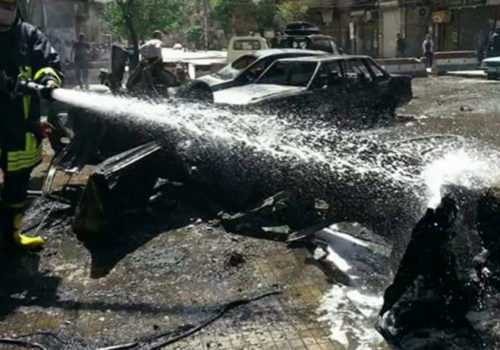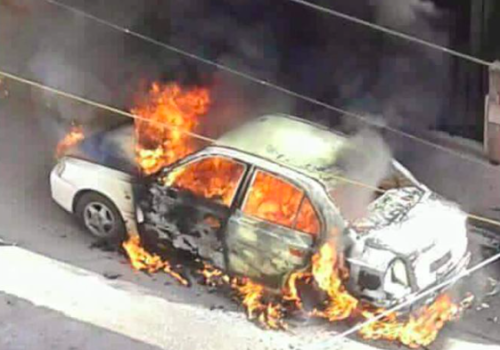May 3, 2016
Jerusalem Notebook: Armenians, Artsakh and the Invisible Hand
Back to Allby Useful Group
Share:
Sunday, April 24 commemorated the 101st anniversary of the Armenian Genocide. The day was observed by the world’s Armenian churches and remembered solemnly in many other Christian gatherings. And, in the face of today’s ongoing genocide in Iraq and Syria, it served as a grim reminder of the terrible abuses Christian communities have endured for centuries – and continue to suffer.
Less than a year after the outbreak of World War I, on April 24, 1915, Ottoman Turkish authorities arrested hundreds of Armenian professors, lawyers, doctors, clergymen and other elites in Constantinople (now Istanbul). These revered members of the community were jailed, tortured and hastily massacred.
But that was only the beginning.
As I wrote for The Philos Project just a year ago, “That mass murder marked the initiation of a death sentence on an entire religious population. When reports of the leaderships’ slaughter spread across Turkey, terror gripped Armenian cities, towns and villages, which in 1915 were home to approximately 2,100,000 souls. According to the University of Minnesota’s Center for Holocaust and Genocide Studies, by 1922, only 387,800 Armenians remained alive.”
Of course, the world’s Armenian Christians can never forget the fate of their forebears in that notorious religious cleansing. And, in fact, anti-Christian forces in the Middle East will not let them forget.
Just over two years ago, in March 2014, Sunni radicals swept through the Armenian village of Kassab, Syria. Early that Friday morning, Kassab was violently attacked, its churches desecrated, its families driven out. Since then, Al-Qaeda-affiliated terrorists have occupied the town’s abandoned homes and businesses.
For both historic and present-day reasons, many of Kassab’s dispossessed victims blame Turkey for turning a blind eye to the invaders as they crossed the nearby Turkish border into Syria; some claimed to have seen injured fighters carried back into Turkey along the same route.
To this day, it is nearly impossible to determine the fate of the Armenian Christians who fled Kassab in 2014. According to several reports, there were hundreds of them. Tragically, some of them were elderly sons and daughters of families that fled the Turks in 1915 and settled in Kassab.
Fast-forward to 2016, and this year brought Armenian Christians yet another bloodstained reminder. On April 26,
Speaking to AsiaNews over the phone from Aleppo, Armenian Sevag Tashdjian said, “Islamic terrorist groups supported by Turkey” who “cross Turkish-Syrian border trafficking arms, ammunition and stolen goods” are responsible.
“We woke up under the bombs; it is Turkey’s gift,” he added. “Entire neighborhoods have caught fire and we went under the bombs to bring relief to sick and elderly trapped in their homes and take them to safety, to safer underground shelters.”
The few open shopkeepers closed their doors, and for the first time in five years of conflict, “anger has overcome fear.” It must be said that the Aleppo Armenians are the group who paid the highest price so far in the war, with the destruction of the ancient churches (including the church of the 40 martyrs, a 17th century architectural jewel). The churches were destroyed by explosives placed in underground tunnels carved from areas controlled by pro-Turkish Islamic terrorists).
According to AsiaNews, the attacks on Aleppo’s Armenian community killed 17, including three children.
A day later, a PDF file was received by my colleague Nina Shea at Hudson Institute’s Center for Religious Freedom, written by the Rev. Haroutune Selimian of Bethel Church in Aleppo (I quote it with permission). It contains further details about the attacks on Aleppo, along with a number of heartbreaking photos.
The situation in Aleppo has taken a turn for the worse since 24th of April 2016. Dozens of mortar bombs have damaged of completely destroyed buildings in the predominately Christian … neighborhoods … as the opposition intensified its offensive in areas of Aleppo held by regime forces.
There has been systematic shelling of Aleppo in the past three days, with the help of artillery, mortar and other kinds of shells. Although the firing is carried out from the same positions, it is not clear which group is conducting it.
We call on all governments, especially Western nations, who are supporting the opposition forces to immediately use their leverage to halt the attacks on Armenian neighborhoods. Those governments which do not work to end the operations will be considered accomplices in the anti-Armenian attacks and all other crimes.
On that same day, other explosions in Armenian areas were also reported, including a bus bombing in Yerevan, Armenia’s capital. That is being investigated.
Another explosion took place in the war-torn Armenian Christian enclave of Nagorno-Karabakh. And that one caught my attention. I have a personal connection to that beautiful, mountainous location.
Many westerners are not even aware of the existence of a place called Nagorno-Karabakh (called Artsakh by the Armenian locals), much less about its recent violent history. Once a part of the ancient Armenian Kingdom – with roots reaching back to the second century – the present upheaval dates back to Stalin’s regime in the USSR, when the dictator’s divisive remapping endeavors surrounded the Artsakh Christians with Islamic Azerbaijan.
I first became acquainted with Nagorno-Karabakh/Artsakh and its beleaguered Christian community just a few years after Sept. 11. I was there with friends who were touring both the Armenian enclave and Yerevan, Armenia. We were guided by Baroness Cox – a heroic human rights advocate who serves in Britain’s House of Lords (I was later to write her biography).
Cox was deeply involved in assisting Nagorno-Karabakh’s Christians during the bloody war that exploded shortly after the demise of the Soviet Union. At that time, Artsakh had voted to secede from Azerbaijan and to unite with Armenia.
As with many such disputes in today’s world, there was a religious component. The Armenian Christians wanted to be independent of the Muslim, Turkish-oriented Azerbaijanis. The memory of the Armenian genocide could never be far from their minds, and they wanted to situate themselves as far away as possible from Turkey’s influence, safely within Armenia’s borders.
The dispute turned violent and deadly once the USSR collapsed, and it was a horrific clash. But somehow – rather miraculously – the ridiculously outmanned, outgunned Armenian/Karabakhi troops defeated the Azeris.
By the time the conflict ended with a shaky peace treaty in 1994, the desperate Azeris had enlisted savage Arab and Afghan jihadi warriors to fight alongside their dispirited troops.
For me, that alone was thought provoking.
Meanwhile, according to observers, the Armenians fought with passion, while the Azeris were increasingly demoralized. The New York Times reported, “In Stepanakert [the capital of Nagorno-Karabakh], it is impossible to find an able-bodied man – whether volunteer from Armenia or local resident – out of uniform. [Whereas in] Azerbaijan, draft-age men hang out in cafes.”
The death toll for the conflict in the early 1990s was some 6,000 Armenians vs. 20,000 Azeris.
Cox – who had managed to provide large shipments of medication and other essential support to the Armenians during the war – led us to various battle sites, where we spoke to Christians who had survived the fighting.
The Archbishop (Armenian Orthodox) of Stepanakert showed me his large and perfectly preserved church, which he described as the “beating heart of Arthsakh.” A number of outbuildings, including a monastery, had been utterly flattened by Azeri Grad missile fire (the topography in Nagorno-Karabakh bears a startling resemblance to the Golan Heights overlooking Galilee).
“It was as if an Invisible Hand had completely covered our church,” the amiable cleric told me with a smile, cupping one hand, shelter-like, above the palm of the other. “Only one bullet hole.”
I could see a tiny puncture in a window at the top of the sanctuary. The lack of damage seemed surreal to me. Something stirred in my soul.
A day or two later, the baroness took us to see the eternal flame, which commemorates the Armenian genocide in Yerevan.
Since 9/11, I had been increasingly conscious of the proverbial line in the sand between the western, Judeo-Christian world and the encroachment of Islamist violence. Clearly we were in a war – not only a war of ideas, but also a war that had already become matter of life and death.
As I stood there, feeling the heat of that memorial furnace nearly scorching my face, I remembered the archbishop’s words. And, more or less without meaning to, I made a quiet decision:
“I want to be on the side of the Invisible Hand.”
I think that decision ultimately led me to Jerusalem, where the same battle is being fought on a daily basis.
As for Nagorno-Karabakh, unfortunately, the conflict is not over. In recent weeks, the worst outbreak of violence since the 1994 ceasefire has erupted. And mightier powers than the locals are staking their claims: Nagorno-Karabakh is becoming a crucible in the simmering feud between Islamist Turkey and Christian Russia.
On the same Sunday morning that Armenian Christians said their prayers of remembrance for the victims of the 1915 genocide, the fighting flared up again: Explosions, howitzers and accusations blasted away on both sides.
Just days later, U.S. Sen. Mark Kirk responded to the Azeri’s aggression:
The time has come for Azerbaijan to face consequences from the United States and the international community for its blatant military aggression against the Nagorno-Karabakh Republic.
After years of saber rattling, Azerbaijan’s four-day assault on the NKR earlier this month is its most egregious attack since it signed a ceasefire agreement with Armenia and the NKR in 1994. These recent military actions indicate the clear need for new measures to modify a cease-fire framework that is not working.
With no system to referee the cease-fire, Azerbaijan has become increasingly belligerent while facing no consequences for its violations. This must change.
The choice for [Azerbaijan’s] President Aliyev is clear: Either he subscribes to diplomatic negotiations with the Armenians under peaceful circumstances or continues with a belligerent and futile policy of attrition.
If he chooses the latter, he should know that every act of Azerbaijani aggression will only further validate the Nagorno-Karabakh Republic’s argument that it go the way of Kosovo.
And so it goes:
Yesterday’s Armenian Genocide.
Today’s genocide of Assyrian Christians and Yazidis in Iraq and Syria.
At the same time, terrorist detonations in Paris, Brussels, Jerusalem and San Bernardino. Massacres in Nigeria and Sudan. Beheadings in Libya and the Philippines.
These are just some of the many battlegrounds in what some journalists are calling “The Long War.”
And we’re all in it. It’s quite true that we haven’t declared war on anyone. But war has been declared on us. So some of us fight with weapons. Others launch assaults with the written word. And some are prayer warriors.
But if you want to know more about what The Long War is all about, just ask the Armenians, the Assyrian Christians, or the Israelis.
And if you want to see the action more clearly yourself, step across the line. Pray for wisdom. Like me, you may unexpectedly find yourself deployed in the service of the Invisible Hand.


